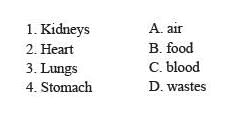Class 7 Exam > Class 7 Tests > Science Olympiad Class 7 > Olympiad Test: Transport And Excretion -2 - Class 7 MCQ
Olympiad Test: Transport And Excretion -2 - Class 7 MCQ
Test Description
10 Questions MCQ Test Science Olympiad Class 7 - Olympiad Test: Transport And Excretion -2
Olympiad Test: Transport And Excretion -2 for Class 7 2025 is part of Science Olympiad Class 7 preparation. The Olympiad Test: Transport And Excretion -2 questions and answers have been
prepared according to the Class 7 exam syllabus.The Olympiad Test: Transport And Excretion -2 MCQs are made for Class 7 2025 Exam. Find important
definitions, questions, notes, meanings, examples, exercises, MCQs and online tests for Olympiad Test: Transport And Excretion -2 below.
Solutions of Olympiad Test: Transport And Excretion -2 questions in English are available as part of our Science Olympiad Class 7 for Class 7 & Olympiad Test: Transport And Excretion -2 solutions in
Hindi for Science Olympiad Class 7 course. Download more important topics, notes, lectures and mock
test series for Class 7 Exam by signing up for free. Attempt Olympiad Test: Transport And Excretion -2 | 10 questions in 20 minutes | Mock test for Class 7 preparation | Free important questions MCQ to study Science Olympiad Class 7 for Class 7 Exam | Download free PDF with solutions
Olympiad Test: Transport And Excretion -2 - Question 1
The droplets of water arranged at the edges of leaves of roses in the morning are
Detailed Solution for Olympiad Test: Transport And Excretion -2 - Question 1
Detailed Solution for Olympiad Test: Transport And Excretion -2 - Question 2
Detailed Solution for Olympiad Test: Transport And Excretion -2 - Question 3
Detailed Solution for Olympiad Test: Transport And Excretion -2 - Question 4
Olympiad Test: Transport And Excretion -2 - Question 5
Blood from the left ventricle is pumped to
Detailed Solution for Olympiad Test: Transport And Excretion -2 - Question 5
Detailed Solution for Olympiad Test: Transport And Excretion -2 - Question 6
Olympiad Test: Transport And Excretion -2 - Question 7
In potato experiment, sugar level inside potato is increased due to
Detailed Solution for Olympiad Test: Transport And Excretion -2 - Question 7
Olympiad Test: Transport And Excretion -2 - Question 8
______ is the flow of water molecules from the region of higher water pressure to the region of lower water pressure through a semipermeable membrane.
Detailed Solution for Olympiad Test: Transport And Excretion -2 - Question 8
Olympiad Test: Transport And Excretion -2 - Question 9
______ animals excrete ammonia in gaseous form.
Detailed Solution for Olympiad Test: Transport And Excretion -2 - Question 9
Detailed Solution for Olympiad Test: Transport And Excretion -2 - Question 10
|
34 videos|88 docs|54 tests
|
Information about Olympiad Test: Transport And Excretion -2 Page
In this test you can find the Exam questions for Olympiad Test: Transport And Excretion -2 solved & explained in the simplest way possible.
Besides giving Questions and answers for Olympiad Test: Transport And Excretion -2, EduRev gives you an ample number of Online tests for practice



















